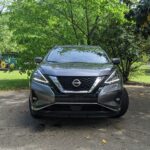Is it possible to find a car that delivers supercar performance without breaking the bank? The Chevrolet C5 Corvette Z06 might just be the answer. Often touted as one of the best performance bargains on the market, the C5 Z06 offers incredible speed and handling for a surprisingly accessible price. But is it really as good as it sounds? We delve into what makes the C5 Z06 so special and what you need to know if you’re considering adding one of these performance icons to your garage.
Why the C5 Z06 Corvette Deserves Your Attention
“The Z06 is my favorite C5, and maybe one of my favorite Corvettes of all time.” This powerful endorsement comes from John Heinricy, a name synonymous with Corvette performance. As the former director of GM Performance and co-chief engineer of the Corvette platform, Heinricy’s opinion carries significant weight. Even in retirement, he chooses a C5 Z06 for his weekend road racing and autocrossing adventures, highlighting its enduring appeal and track prowess.
Heinricy explains the Z06’s origin, revealing it was born from the Fixed Roof Coupe (FRC). Initially conceived as a potentially more affordable Corvette variant, the FRC’s lighter and stiffer structure proved to be a better foundation for a performance model. This realization led to the birth of the Z06, a car that prioritized handling and power over entry-level pricing. This strategic shift by GM resulted in a true performance machine.
The C5 generation Corvette, launched in 1997, was a significant leap forward. The FRC, introduced in 1999, further enhanced the chassis stiffness by incorporating bracing from the convertible model and adopting a lighter roof design, replacing the standard Corvette’s large glass hatch. Coupled with the performance-oriented Z51 suspension as standard, the FRC became the best-handling C5 Corvette available at the time. However, Chevrolet knew that superior handling deserved equally impressive power.
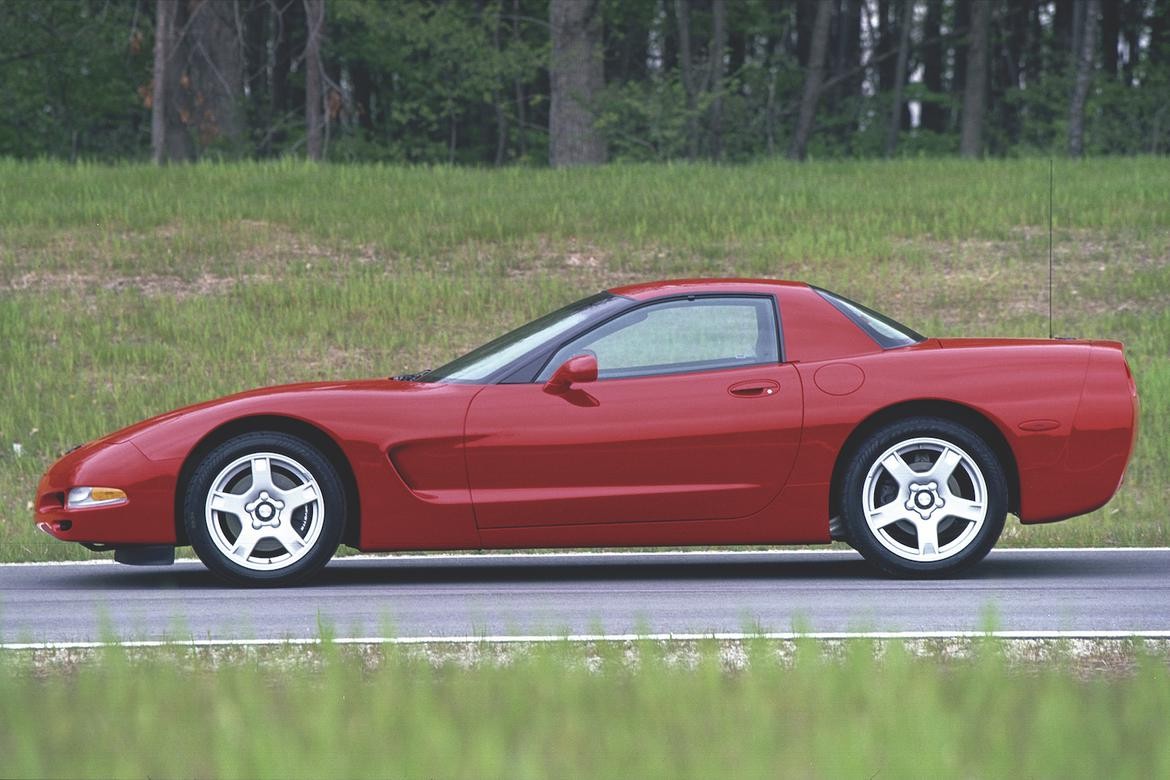 Chevrolet Fixed Roof Coupe, the precursor to the C5 Z06 Corvette, highlighting its distinctive roofline and enhanced chassis stiffness
Chevrolet Fixed Roof Coupe, the precursor to the C5 Z06 Corvette, highlighting its distinctive roofline and enhanced chassis stiffness
The Birth of the C5 Z06: Power Meets Precision
The first C5 Z06 Corvette debuted in 2001, marking a new era of Corvette performance. It retained the FRC’s rigid and lightweight structure and introduced the potent LS6 engine, a 5.7-liter V8 producing 385 horsepower. This was a substantial 40 horsepower increase over the standard C5 Corvette, immediately setting the Z06 apart.
Chevrolet didn’t stop at just engine upgrades. The Z06 received further enhancements aimed at reducing weight and maximizing performance. These included thinner glass, a lightweight titanium exhaust system, and the removal of sound deadening materials. The result was a Corvette that delivered unprecedented performance figures, rivaling some of the world’s most prestigious sports cars.
The pursuit of performance didn’t end with the 2001 model. For the 2002 model year, Chevy engineers refined the LS6 engine even further. By incorporating a lighter valvetrain and tweaking the intake system, they boosted power output to an impressive 405 horsepower. This iteration of the C5 Z06 could accelerate from 0 to 60 mph in a mere 4 seconds, achieving lap times on par with supercars costing significantly more.
The 2003 and 2004 model years saw minor refinements focused on enhancing reliability and overall refinement. Notable upgrades included improved shock absorbers on the 2004 models. However, the core performance and specifications of the 2002 through 2004 C5 Z06 Corvettes remained essentially consistent, making them highly desirable years for enthusiasts seeking peak performance.
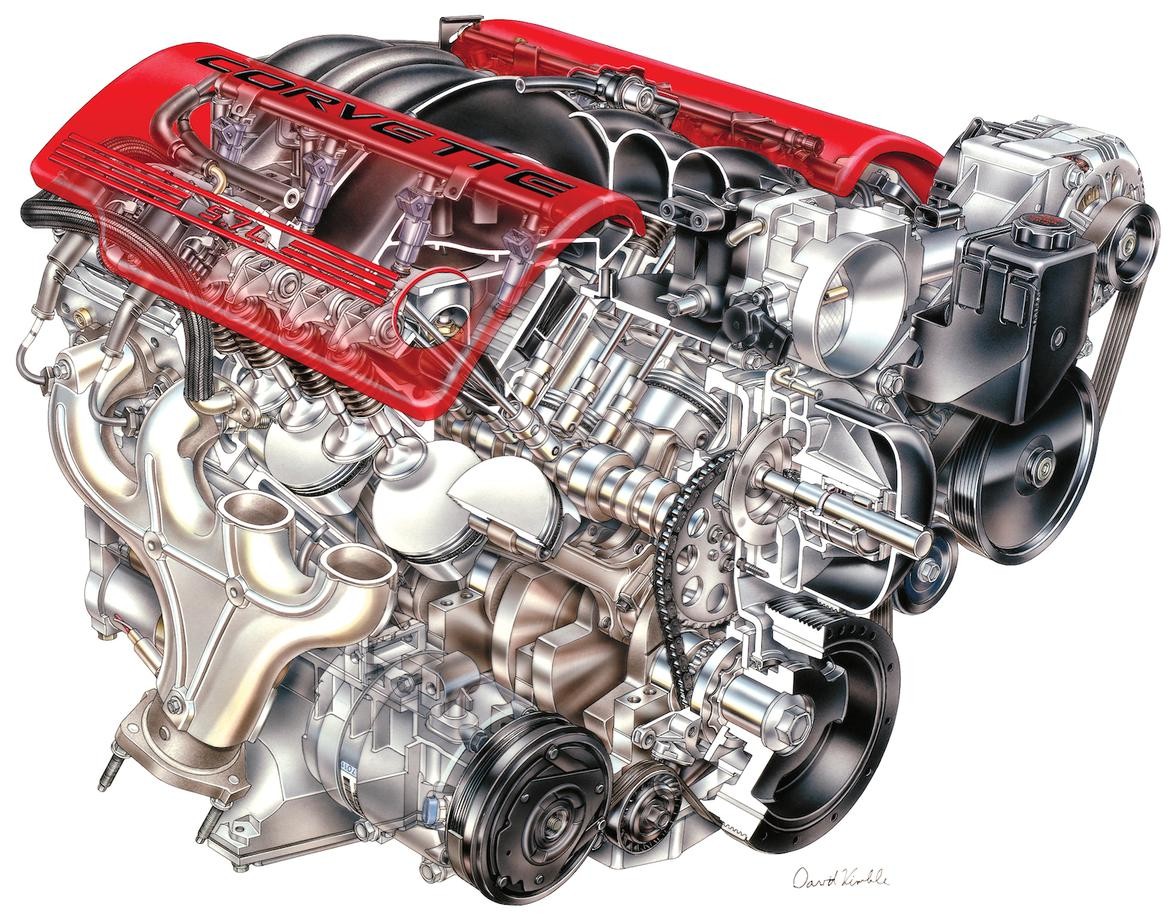 The LS6 V8 engine, the heart of the C5 Z06 Corvette, known for its robust performance and power output of 405 horsepower in later models
The LS6 V8 engine, the heart of the C5 Z06 Corvette, known for its robust performance and power output of 405 horsepower in later models
Finding Your C5 Z06: Acquisition Considerations
Convinced that a C5 Z06 is the right car for you? The good news is that Chevrolet produced a significant number of these performance machines, offering a wide selection on the used market. However, navigating the buying process requires some knowledge to ensure you get the best value and avoid potential pitfalls.
While the 2001 C5 Z06 with 385 horsepower is available at a potentially lower price point, it’s often recommended to focus on the 2002-2004 models. The performance difference between the earlier and later models is significant, and the price gap in the used market is often not substantial enough to justify sacrificing the extra power. Furthermore, for competitive events, the 2001 model may be classed alongside the more powerful versions, putting it at a disadvantage.
When considering 2002-2004 models, the differences become more nuanced. While there were minor production changes aimed at improving durability, these are less critical when purchasing a used car, especially considering typical maintenance and parts replacements over the years. For instance, later models received slightly different wheel hubs, but replacement parts today generally reflect the updated specifications, negating any significant advantage of a later production year in this aspect.
However, one key running change does warrant attention: the introduction of lighter valvetrain components in 2002. This change, while boosting performance, initially led to a higher incidence of valve spring failures, particularly in 2002 models. The issue was less prevalent in 2003, and statistically insignificant in 2004, suggesting Chevrolet addressed and resolved the problem over these years. For any 2002 or 2003 C5 Z06, valve spring replacement with updated, more robust springs should be considered a crucial preventative maintenance item. Fortunately, this is a relatively inexpensive and straightforward repair for these pushrod engines.
Beyond valve springs, another common issue in C5 Z06 Corvettes is related to the harmonic balancer, or crank pulley. The rubber bushing within the pulley can degrade over time, causing wobble. If left unaddressed, this can lead to serious engine problems. Fortunately, a replacement OE pulley is reasonably priced and should be viewed as a wear item. When replacing the pulley, it’s advisable to use an ARP bolt, and crucially, the original OE bolt should never be reused as it is designed for single use.
Engine-wise, the LS6 is renowned for its robustness and longevity. With proper maintenance, these engines are capable of high mileage, even in demanding conditions like track use. Stories of track-driven C5 Z06 Corvettes exceeding 200,000 miles without major engine issues are not uncommon. Therefore, when evaluating a used C5 Z06, focusing on maintenance history is more critical than simply odometer reading.
The interior of a high-mileage C5 Z06 is often where wear and tear become most apparent. GM interiors from this era are not known for their luxuriousness or exceptional durability. Common issues include wear on the driver’s seat, such as cracked leather and deteriorated foam, and general cabin rattles and squeaks as plastic components age.
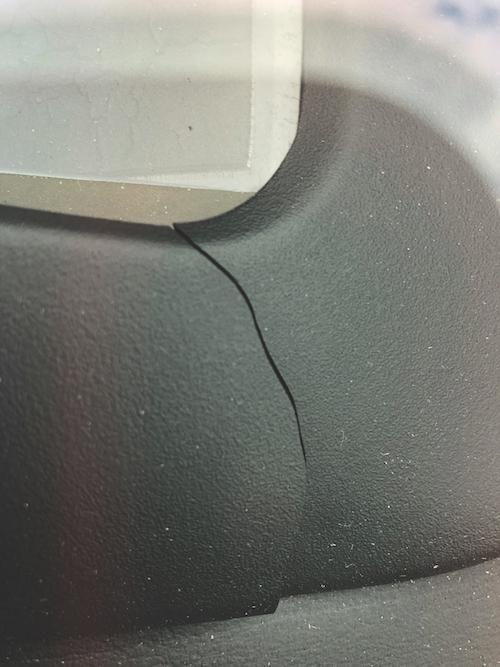 Interior wear on a C5 Z06 Corvette, showing typical bolster wear on the driver's seat and cracking on the HUD bezel
Interior wear on a C5 Z06 Corvette, showing typical bolster wear on the driver's seat and cracking on the HUD bezel
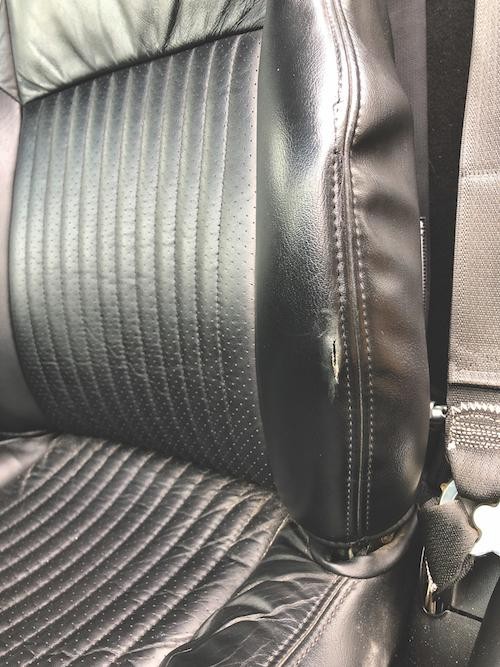 Close-up of C5 Z06 Corvette driver's seat wear, highlighting cracked leather and foam degradation common in high-mileage examples
Close-up of C5 Z06 Corvette driver's seat wear, highlighting cracked leather and foam degradation common in high-mileage examples
Fortunately, the aftermarket provides extensive solutions for C5 Corvette interior refurbishment. Companies like Mid America Motorworks offer comprehensive seat rebuild kits, including replacement leather and foam, at reasonable prices. They also supply replacements for various interior trim pieces and plastic components. For example, the C5 Z06’s Head-Up Display (HUD) bezel is prone to cracking, and aftermarket solutions are available, including overlays that offer a factory-look repair without full replacement complexity. While interior condition can indicate overall vehicle care, the availability of repair and replacement parts means it shouldn’t be a deal-breaker if other aspects of the car are sound. A well-maintained, high-mileage Z06 with a pristine interior is a strong indicator of meticulous ownership.
Chassis components are generally durable, but age-related wear is inevitable. Control arm bushings are known to wear out over time, potentially necessitating complete control arm replacement, especially if maintaining stock configuration is a requirement for intended use, such as in certain racing classes. Aftermarket control arms are available at lower prices than OE parts, but quality can vary, and longevity may be compromised. The decision to opt for OE versus aftermarket parts often involves balancing cost and long-term durability. However, being a GM product, and a popular one at that, parts availability and pricing for the C5 Corvette, including Z06 specific components, remain relatively affordable.
C5 Z06 Corvette Pricing and Market Value
So, what can you expect to pay for a C5 Z06 Corvette? According to valuation guides like Kelley Blue Book and NADA, a clean 2004 Z06 with around 50,000 miles should be priced in the vicinity of $20,000. Dealer prices might be slightly higher, while private sales could be a bit lower, but $20,000 serves as a reasonable benchmark.
However, real-world market prices may slightly exceed these “book values,” suggesting a potential upward trend in C5 Z06 values. While some may claim that C5 Z06s are readily available for as low as $15,000, cars at that price point are often either in poor condition or have undisclosed issues. Finding a well-maintained, problem-free C5 Z06 typically requires a budget in the $19,000 to $23,000 range. Spending towards the higher end of this range often secures a car in excellent condition with minimal to no immediate needs, while lower-priced examples may require some investment to address deferred maintenance or minor issues, potentially bringing the total expenditure closer to the higher end anyway.
Starting the search at the higher end of the price range can be advantageous, as it increases the likelihood of finding a car with fewer hidden problems. At around $23,000, a good selection of C5 Z06 Corvettes is typically available nationwide, often through reputable dealerships offering inspections and pre-sale services. However, as with any used car purchase, careful due diligence and smart shopping are essential to avoid less scrupulous sellers.
Our own acquisition story led us to a 2004 Le Mans Commemorative Edition C5 Z06. This special edition, celebrating the Corvette’s Le Mans victory, features a unique Le Mans Blue paint scheme with silver stripes and a lightweight carbon-fiber hood, weighing 10.6 pounds less than the standard fiberglass hood. While the weight savings are marginal, the Commemorative Edition is considered the most desirable and collectible of the C5 Z06 models.
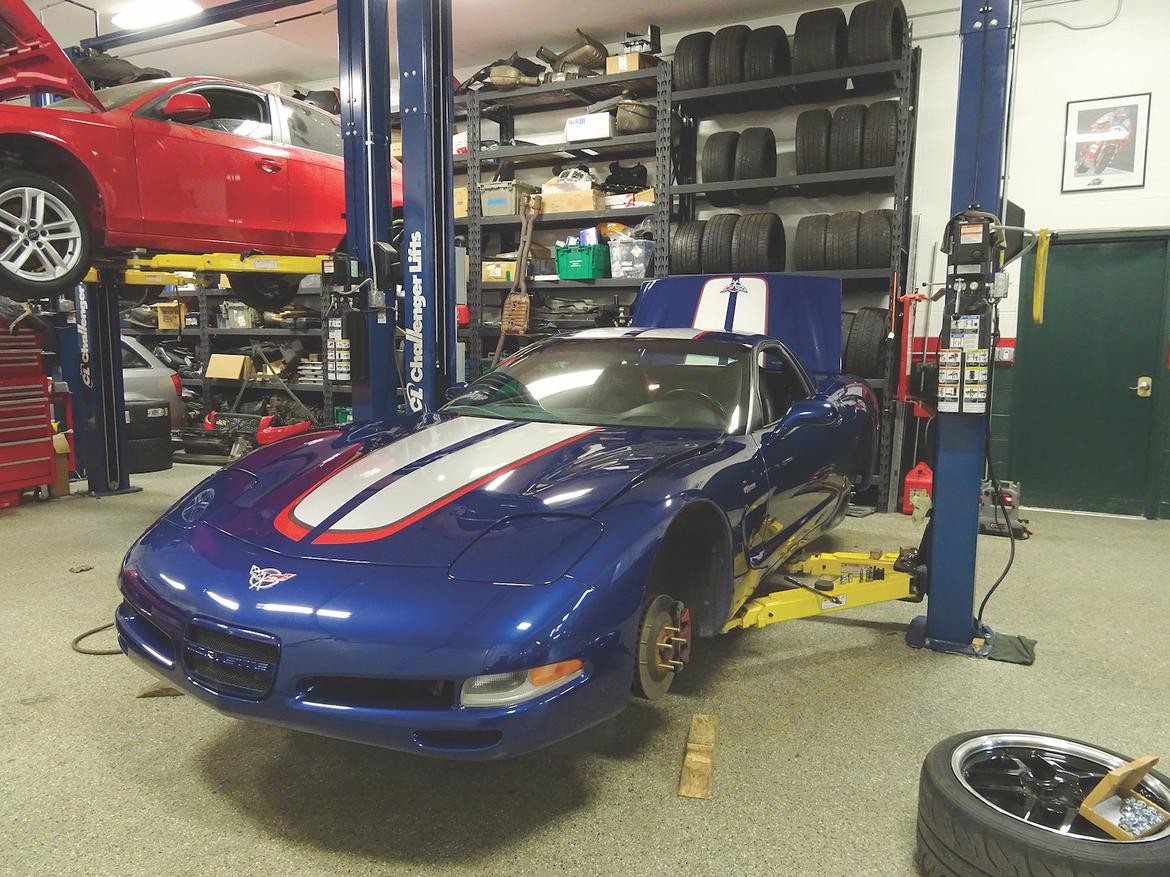 The Le Mans Commemorative Edition C5 Z06 Corvette, showcasing its unique blue paint, silver stripes, and lightweight carbon fiber hood
The Le Mans Commemorative Edition C5 Z06 Corvette, showcasing its unique blue paint, silver stripes, and lightweight carbon fiber hood
Valuation guides suggest a premium of around $1,500 for the Commemorative Edition over a standard Z06 in comparable condition. While this premium may seem significant upfront, it’s expected to appreciate as these cars become increasingly sought after as modern classics.
Our purchase price for the Commemorative Edition Z06 was $18,500. It was owned by an autocross and track day enthusiast in the Chicago area and included extra wheels and an aftermarket front anti-roll bar from Strano Performance Parts – a desirable upgrade for performance driving. With 94,000 miles on the odometer and appearing excellent in photos, the price seemed almost too good to be true.
Upon further inquiry, the seller disclosed that the car had experienced a track incident, hitting a tire wall. Damage was limited to driver-side fiberglass and minor bumper cover rash, and importantly, the carbon fiber hood remained undamaged. The seller and his brother professionally repaired the car, even proactively replacing several suspension components as a precaution. The repairs were well-documented and appeared to be of high quality. Despite the car’s history, the attractive price, ultimately negotiated down to slightly under $18,000, reflected the calculated risk taken with a previously damaged vehicle.
Initial Impressions and Next Steps
After purchasing the C5 Z06 in Chicago, our first stop was Greenwood Motorsports in Evanston, Illinois, managed by championship driver Jason Saini. A thorough inspection on a lift confirmed the previous owner’s quality repair work. The fit and finish of the repaired areas were excellent, and the presence of fresh hubs and control arms on one side was an unexpected bonus.
The car showed some expected wear, primarily on the driver’s seat and a few minor interior trim pieces replaced with non-original parts. However, overall condition was deemed very good, requiring only minor cosmetic attention to reach excellent condition – a worthwhile trade-off given the purchase price savings.
We also equipped the Z06 with a set of BFGoodrich g-Force Rival S tires at Greenwood Motorsports, ready for immediate autocross use. While the initial autocross experience was hampered by cold and wet conditions, the drive back to Florida demonstrated the Corvette’s comfortable and capable nature, achieving 24 mpg fuel economy, aligning with EPA estimates. A stop at Mid America Motorworks en route provided further inspiration with their extensive Corvette parts inventory and museum.
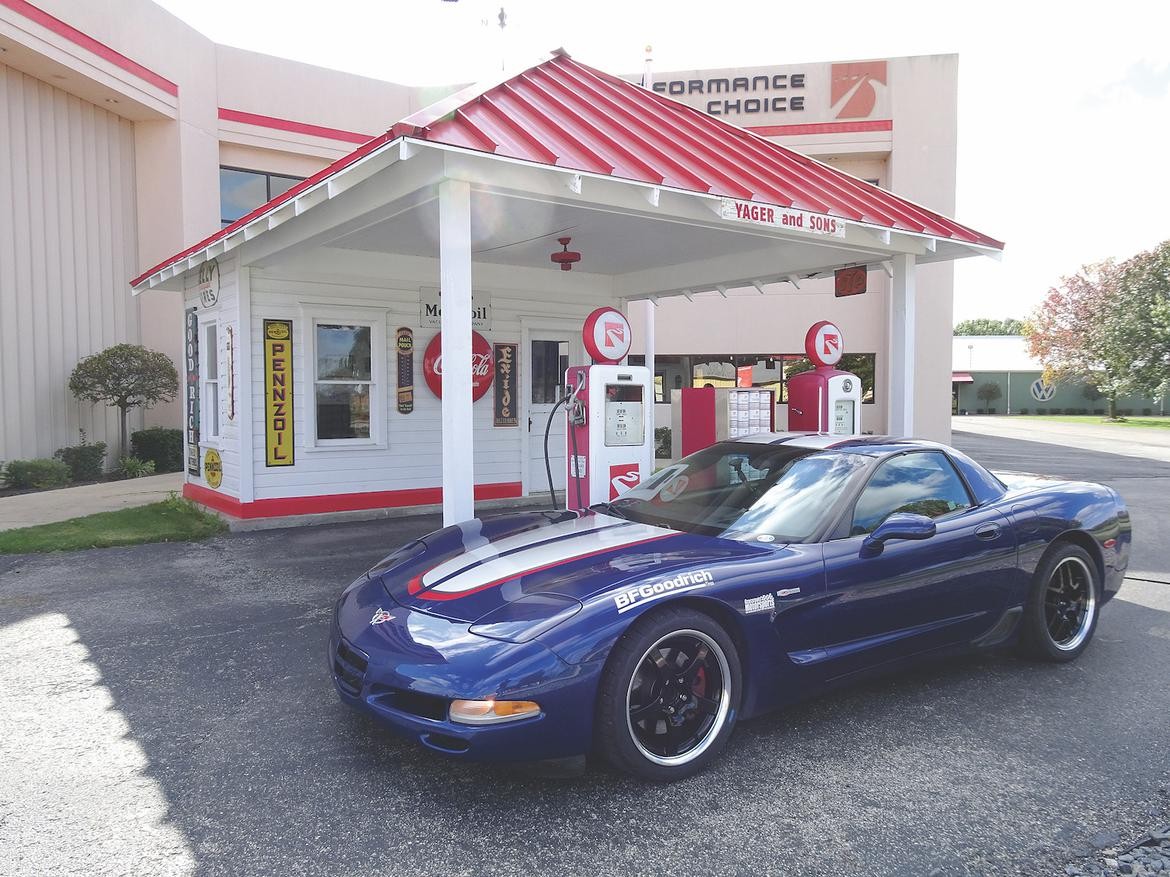 The C5 Z06 Corvette on a lift at Greenwood Motorsports for a post-purchase inspection, ensuring its mechanical soundness and repair quality
The C5 Z06 Corvette on a lift at Greenwood Motorsports for a post-purchase inspection, ensuring its mechanical soundness and repair quality
In upcoming articles, we will detail our project of further enhancing our C5 Z06. Initially focusing on SCCA Solo and NASA Time Trial competitions in stock classes, our modifications will be targeted and strategic, aiming to maximize the already exceptional chassis performance. The C5 Z06 platform offers immense potential, and we are excited to explore its limits and share our journey of refining this already incredible machine.

